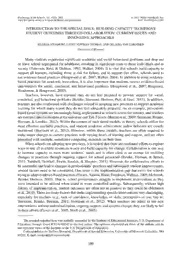
ERIC ED540742: Introduction to the Special Issue: Building Capacity to Improve Student Outcomes through Collaboration--Current Issues and Innovative Approaches PDF
Preview ERIC ED540742: Introduction to the Special Issue: Building Capacity to Improve Student Outcomes through Collaboration--Current Issues and Innovative Approaches
PsychologyintheSchools,Vol.49(5),2012 (cid:2)C 2012 WileyPeriodicals,Inc. Viewthisarticleonlineatwileyonlinelibrary.com/journal/pits DOI:10.1002/pits.21605 INTRODUCTIONTOTHESPECIALISSUE:BUILDINGCAPACITYTOIMPROVE STUDENTOUTCOMESTHROUGHCOLLABORATION:CURRENTISSUESAND INNOVATIVEAPPROACHES MELISSASTORMONT,CATHYNEWMANTHOMAS,ANDDELINDAVANGARDEREN UniversityofMissouri Many students experience significant academic and social behavioral problems and drop out or leave school unprepared for adulthood, resulting in significant costs to these individuals and to society (Patterson, Reid, &Dishion, 1992; Walker, 2004). Itis vital thatschools build capacity to support all learners, including those at risk for failure, and to support this effort, schools need to useevidence-basedpractices(Hoagwoodetal.,2007;Walker,2004).Inadditiontousingevidence- based practices for academic instruction, it is also important that students receive evidence-based interventions for social, emotional, and behavioral problems (Hoagwood et al., 2007; Ringeisen, Henderson,&Hoagwood,2003). Teachers, however, have reported they do not feel prepared to provide support for social, emotional,andbehavioralproblems(Reinke,Stormont,Herman,Puri,&Goel,2011).Inaddition, teachersarealsoconfrontedwithchallengesrelatedtoadoptingnewpracticestosupportacademic learning for which many report they do not feel adequately prepared. As an example, prevention- basedtieredsystemsareincreasinglybeingimplementedinschoolsacrossthecountry,andteachers areessentialinterventionistsattheuniversalandTier-2levels(Horneretal.,2009;Stormont,Reinke, Herman,&Lembke,2012).Withinthecontextofsuchtieredmodels,intheory,schoolsutilizethe most effective available practices, and student academic achievement and/or behavior are closely monitored (Stormont et al., 2012). However, within these models, teachers are often required to makemajorchangestocurrentpracticeswithvaryinglevelsoftrainingandsupport,andareoften presentedwithmultiple,sometimescompeting,demandsontheirtime. Whenschoolsareadoptingnewpractices,itiscriticalthattherearecontinuedeffortstoexplore waystouseallavailableresourceswiselyandbuildcapacityforchange.Collaborationisoneway to increase capacity to meet more students’ needs and is often cited as an avenue for instilling changes in practices through ongoing support for school personnel (Reinke, Herman, & Sprick, 2011;Turnbull,Turnbull,Erwin,Soodak,&Shogren,2011).However,forcollaborativeeffortsto besuccessfulandleadtochangesinprofessionals’practicesandsubsequentstudentimprovements, several factors need to be considered. One issue is the implementation gap that exists for schools tryingtoadoptevidence-basedpractices(Fixsen,Naoom,Blase,Friedman,Wallace,2005;McIntosh, Reinke, Herman, 2010). That is, school professionals struggle to implement interventions as they were intended to be utilized when tested in more controlled settings. Subsequently, without high fidelity of implementation, student outcomes are often not as positive as they could be (McIntosh etal.,2010).Therearemanyfactorsthatmakeimplementingspecificinterventionsverychallenging, especially for teachers (e.g., lack of confidence, knowledge, or skills; perceptions of use; buy-in; Stormont, Reinke, Herman, 2011; Stormont et al., 2012). When teachers are asked to use new interventionswithoutindividualization,ongoingsupport,andsystemschange,theyarelikelytofail intheirefforts(Fixsenetal.,2005;Noelletal.,2005). TheresearchreportedherewaspartiallysupportedbytheInstituteofEducationalSciences,U.S.Departmentof Education,throughGrantR305A100342tothefirstauthor.Theopinionsexpressedarethoseoftheauthorsanddo notrepresentviewsoftheInstituteortheU.S.DepartmentofEducation. Correspondenceto:MelissaStormont,DepartmentofSpecialEducation,UniversityofMissouri,Columbia,MO 65211.E-mail:[email protected] 399 400 Stormont,Thomas,andGarderen Overall, it is important to understand both the collaborative practices that are supported by researchandthechallengestogettingthesepracticesimplemented(Durlak&DuPre,2008).School psychologistsoftenplayakeyroleinidentifying,monitoringimplementationfidelity,andhelping schoolsbringnewpracticestoscale.Tothisend,thisissueincludessevenarticlesthataddresstopics related to innovative models or programs to support increased collaboration and current issues relatedtocollaboration.Thefirsttwoarticlesprovideexamplesofcollaborativeinterventionmodels tosupportstudentsthroughbuildingteachers’instructionalandclassroommanagementskills.Inthe firstarticle,Vo,Sutherland,andConroypresenttheirBESTinCLASSmodel(Behavioral,Emotional, andSocialTraining:CompetentLearnersAchievingSchoolSuccess),whichwasdesignedforearly childhood programs. This model includes universal interventions designed to increase the use of effectiveinstructionalpractices.Thespecificfocusofthemodelistosupportteachersineffectively intervening with children at the Tier-2 level through improving the quality of teacher–student interactions. In the second article, Reinke, Stormont, Webster-Stratton, Newcomer, and Herman, describe howcoachingisutilizedtoprovidegeneralizationsupportforteacherswithintheIncredibleYears Teacher Classroom Management Program (IY TCM). More specifically, the article describes the IYTCM,whichincludesaseriesofgroup-basedtrainingsonspecifictopicsintroducedovertime (e.g.,effectivebehaviormanagement,strategiesforbuildingteacher–childrelationshipskills,parent– teachercollaboration)andprovidesexamplesofhowspecificprinciplesoftheprogramaresupported intheclassroomsettingthroughanonsitecoach. The focus of the next two articles turns to building capacity to support teachers in learning howtoprovide differenttypesofinstructionalsupportsforstudents.Thearticlebyvan Garderen, Hanuscin,Lee,andKohndescribesacollaborativeprogram,QUEST:QualityElementaryScience Teaching,designedbyteachereducatorsinbothscienceeducationandspecialeducationtosupport teachers’implementationofinquiry-basedinstruction,formativeassessment,andUniversalDesign for Learning as ways to meet the needs of diverse learners in kindergarten through sixth-grade classrooms. Thenextarticlealsofocusesonanunderrepresentedareaintheresearch,specificallyinfusing technology to support students. The article by Thomas, Hassaram, Rieth, Raghavan, Kinzer, and Mulloy presents findings from a university–school partnership in which researchers and teachers collaborated to integrate technology and support teachers in implementing multimedia-anchored instructionwithinanintegratedlanguageartsandsocialstudiescurriculumfordiversemiddle-school students.Thesetwoarticlesshareafocusonlearner-centeredcurriculum,emphasizingmethodsthat fosterthedevelopmentofhigherorderthinkingskillsandprovidingaccesstothecurriculumforall students. The fifth article addresses an emerging challenge many school districts and states are facing relatedtoeffectivelyintegratingmodelsforsupportingsocialbehaviorandliteracypractices.Inthis article, Chaparro, Smolkowski, Baker, Hanson, and Ryan-Jackson, present a model, the Effective BehavioralandInstructionalSupportSystems(EBISS),thattheyarecurrentlyevaluating.Interesting dataoncapacity-buildingeffortsacross140elementaryschoolsarepresented. Commonthemesacrossthefirstfivearticleshighlightthepointthattoensureevidence-based practices are actually practiced by the intended professionals, it is important to provide sustained and ongoing assistance through professional development and onsite support. These articles also illustrate the need for both structure and flexibility. Adult learners, like younger learners, need differenttypesofsupporttoacquire,generalize,andsustaintheiruseofnewskills. The final two articles address knowledge to date pertaining to collaborative models from systematic literature reviews. The first review by van Garderen, Stormont, and Goel specifically targetscollaborationbetweengeneraleducatorsandspecialeducatorsandexplorestheliteratureon PsychologyintheSchools DOI:10.1002/pits BuildingCapacityThroughCollaboration 401 theimpactofthiscollaborationonstudentoutcomes.Inthefinalarticle,Solis,Vaughn,Swanson, andMcCulleyexplorethebroaderliteraturebaseoninclusionandco-teachingandpresentteachers’ perceptions of and needs for support for collaboration to be successful, as well as what is known aboutspecificmodels. SUMMARY Schools across the country are trying to build capacity to meet the diverse needs of learners. Schoolpsychologistsareoftenexpectedtoplayakeyroleincapacitybuildingandsystemicchange. Manystudentshaveorareatriskforhavingsignificantacademicandsocial–emotionalproblems, andtodate,schoolshavenotbeenwellequippedtosuccessfullyrespondandintervene.Thisspecial issuehighlightstheneedforincreasedattentiontosuccessfulcollaborativemodelsandtoinnovative and intensive approaches to bridging the gaps between practice and research and research and practicethroughongoingsupportandsustainedefforts. REFERENCES Durlak,J.A.,&DuPre,E.P.(2008).Implementationmatters:areviewofresearchontheinfluenceofimplementation on program outcomes and the factors affecting implementation. American Journal of Community Psychology, 41, 327–350. Fixsen,D.,Naoom,S.,Blase,K.,Friedman,R.,&Wallace,F.(2005).Implementationresearch:Asynthesisoftheliterature (FMHIPublication#231).Tampa,FL:UniversityofSouthFlorida,LouisdelaParteFloridaMentalHealthInstitute, TheNationalImplementationResearchNetwork. Hoagwood,K.,Olin,S.,Kerker,B.,Kratochwill,T.,Crowe,M.,&Saka,N.(2007).Empiricallybasedschoolinterventions targeted at academic and mental health functioning. Journal of Emotional and Behavioral Disorders, 15, 66–92. doi:10.1177/10634266070150020301 Horner,R.H.,Sugai,G.,Smolkowski,K.,Eber,L.,Nakasato,J.,Todd,A.W.,etal.(2009).Arandomized,wait-listcontrolled effectivenesstrialassessingschool-widepositivebehaviorsupportinelementaryschools.JournalofPositiveBehavior Interventions,11,133–144. McIntosh,K.,Reinke,W.M.,&Herman,K.C.(2010).School-wideanalysisofdataforsocialbehaviorproblems:Assessing outcomes,selectingtargetsforintervention,andidentifyingneedforsupport.InG.Peacock,R.Ervin,E.Daly,&K. Merrell(Eds.),Practicalhandbookofschoolpsychology:Effectivepracticesforthe21stCentury(pp.135–156).New York:GuilfordPress. Noell,G.H.,Witt,J.C.,Slider,N.J.,Connell,J.E.,Gatti,S.L.,Williams,K.L.,etal.(2005).Treatmentimplementation followingbehavioralconsultationinschools:Acomparisonofthreefollow-upstrategies.SchoolPsychologyReview, 34,87–106. Patterson,G.R.,Reid,J.B.,&Dishion,T.J.(1992).Antisocialboys.Eugene,OR:CastaliaPress. Reinke,W.M.,Herman,K.C.,&Sprick,R.(2011).Motivationalinterviewingforeffectiveclassroommanagement:The ClassroomCheck-up.NewYork:GuilfordPress. Reinke,W.M.,Stormont,M.,Herman,K.C.,Puri,R.,&Goel,N.(2011).Supportingchildren’smentalhealthinschools: Teacherperceptionsofneeds,roles,andbarriers.SchoolPsychologyQuarterly,26,1–13. Ringeisen,H.,Henderson,K.,&Hoagwood,K.(2003).Contextmatters:Schoolsandthe“researchtopracticegap”in children’smentalhealth.SchoolPsychologyReview,32,3–16. Stormont,M.,Reinke,W.,Herman,K.,&Lembke,E.(2012).Tiertwointerventions:Academicandbehaviorsupportsfor childrenatriskforfailure.NewYork:GuilfordPress. Stormont,M.,Reinke,W.M.,&Herman,K.C.(2011).Teachers’knowledgeofevidence-basedinterventionsandavailable schoolresourcesforchildrenwithemotionalorbehavioralproblems.JournalofBehavioralEducation,20,138–147. Turnbull,A.,&Turnbull,R.,Erwin,E.,Soodak,L.,&Shogren,K.A.(2011).Families,professionals,andexceptionality: Positiveoutcomesthroughpartnershipandtrust(6thed.).UpperSaddleRiver,NJ:Pearson. Walker,H.M.(2004).Commentary:Useofevidence-basedinterventionsinschools:Wherewe’vebeen,whereweare,where weneedtogo.SchoolPsychologyReview,33,398–407. PsychologyintheSchools DOI:10.1002/pits
